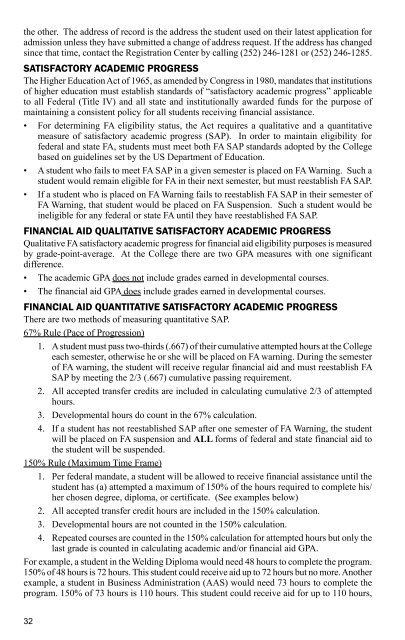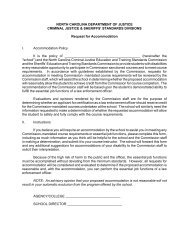Student Handbook - Wilson Community College
Student Handbook - Wilson Community College
Student Handbook - Wilson Community College
You also want an ePaper? Increase the reach of your titles
YUMPU automatically turns print PDFs into web optimized ePapers that Google loves.
the other. The address of record is the address the student used on their latest application foradmission unless they have submitted a change of address request. If the address has changedsince that time, contact the Registration Center by calling (252) 246-1281 or (252) 246-1285.Satisfactory Academic ProgressThe Higher Education Act of 1965, as amended by Congress in 1980, mandates that institutionsof higher education must establish standards of “satisfactory academic progress” applicableto all Federal (Title IV) and all state and institutionally awarded funds for the purpose ofmaintaining a consistent policy for all students receiving financial assistance.• For determining FA eligibility status, the Act requires a qualitative and a quantitativemeasure of satisfactory academic progress (SAP). In order to maintain eligibility forfederal and state FA, students must meet both FA SAP standards adopted by the <strong>College</strong>based on guidelines set by the US Department of Education.• A student who fails to meet FA SAP in a given semester is placed on FA Warning. Such astudent would remain eligible for FA in their next semester, but must reestablish FA SAP.• If a student who is placed on FA Warning fails to reestablish FA SAP in their semester ofFA Warning, that student would be placed on FA Suspension. Such a student would beineligible for any federal or state FA until they have reestablished FA SAP.Financial Aid Qualitative Satisfactory Academic ProgressQualitative FA satisfactory academic progress for financial aid eligibility purposes is measuredby grade-point-average. At the <strong>College</strong> there are two GPA measures with one significantdifference.• The academic GPA does not include grades earned in developmental courses.• The financial aid GPA does include grades earned in developmental courses.Financial Aid Quantitative Satisfactory Academic ProgressThere are two methods of measuring quantitative SAP.67% Rule (Pace of Progression)1. A student must pass two-thirds (.667) of their cumulative attempted hours at the <strong>College</strong>each semester, otherwise he or she will be placed on FA warning. During the semesterof FA warning, the student will receive regular financial aid and must reestablish FASAP by meeting the 2/3 (.667) cumulative passing requirement.2. All accepted transfer credits are included in calculating cumulative 2/3 of attemptedhours.3. Developmental hours do count in the 67% calculation.4. If a student has not reestablished SAP after one semester of FA Warning, the studentwill be placed on FA suspension and ALL forms of federal and state financial aid tothe student will be suspended.150% Rule (Maximum Time Frame)1. Per federal mandate, a student will be allowed to receive financial assistance until thestudent has (a) attempted a maximum of 150% of the hours required to complete his/her chosen degree, diploma, or certificate. (See examples below)2. All accepted transfer credit hours are included in the 150% calculation.3. Developmental hours are not counted in the 150% calculation.4. Repeated courses are counted in the 150% calculation for attempted hours but only thelast grade is counted in calculating academic and/or financial aid GPA.For example, a student in the Welding Diploma would need 48 hours to complete the program.150% of 48 hours is 72 hours. This student could receive aid up to 72 hours but no more. Anotherexample, a student in Business Administration (AAS) would need 73 hours to complete theprogram. 150% of 73 hours is 110 hours. This student could receive aid for up to 110 hours,32







